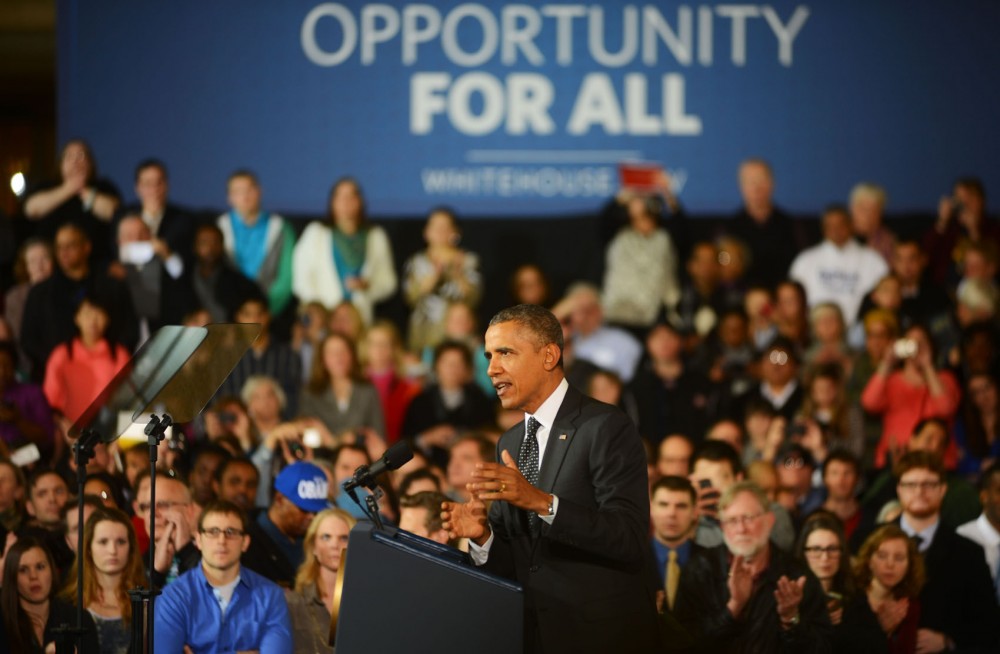President Barack Obama took over the Union Depot in St. Paul on Wednesday, rallying support to bridge political divides and boost federal funding for road and highway improvements across the country.
Against the backdrop of the renovated transit hub, the president praised Minnesota transportation projects, like the Central Corridor light rail, while announcing a four-year, $302 billion transportation plan.
“Rebuilding our infrastructure is vital to business,” Obama said to the crowd of 1,300. “It creates good paying jobs that, by the way, cannot be outsourced. This is one of Congress’ major responsibilities — helping states and cities fund new infrastructure projects.”
The transportation bill — and the funding it provides — expires this fall, which the White House said puts 700,000 jobs across the country at risk. The president urged Congress to work with him on the proposal, calling it “common sense.”
Republicans have controlled the U.S. House of Representatives for the last four years, halting the president’s agenda and spurring battles over issues like immigration reform, the economy, global trade and the minimum wage.
Increasing transportation funding could become one of those fights.
“As we look at the second term, it’s very hard to point to anything that suggests that the president remains a driving force in American politics,” said Humphrey School of Public Affairs professor Larry Jacobs.
The president has been making stops across the country to garner support for proposals he outlined in his State of the Union Address last month, calling it his “year of action,” in which he’ll use his executive authority whenever possible.
“I think what the president is doing at this point is trying to go across the country and put a political pressure on Republicans on quite a variety of issues that he thinks that there’s broad support on,” said Hamline University School of Law adjunct professor David Schultz.
In Minnesota, the president can point to the state’s leadership and use it as an example of how to address certain issues, like transportation initiatives and raising the minimum wage.
“He’s picking a state which is democratically controlled, and he can say, ‘Look at the state of Minnesota. Here’s what they’re doing in terms of all this legislation that’s getting passed,’” Schultz said.
Minnesota nice
No longer a personal re-election campaign, Obama’s cross-country touring now focuses on bolstering Democratic support and pressuring Congress to cooperate.
With a democratic governor and state Legislature, the majority of Minnesota’s leaders back the president’s agenda, so it makes sense that he came here, Schultz said.
“It’s a state he’s going to get favorable reception [in],” he said. “It’s a state where he’s still relatively popular.”
Though the president’s approval rating in Minnesota is under 50 percent — similar to the national average — the state gives Obama’s job performance higher marks compared to most states.
“Many parts of the country don’t want to see him,” Jacobs said. “Minnesota is one of those places where he’s unpopular, but not as deeply unpopular as he is elsewhere.”
Obama was last in Minnesota in February 2013 to discuss gun control with state and city leaders.
Humphrey School senior fellow Harry Boyte said that the state is known for high citizen involvement. The Twin Cities and their suburbs had the highest level of civic engagement of any major metropolitan area in 2010.
“Obama always engages audiences on a larger issue of how they can get involved,” Boyte said.
With a widening partisan gap in his job approval ratings, Obama is on track to have the most politically polarized job approval ratings of any president, according to Gallup research.
That divergence in ratings may result directly from his actions as president or could simply be tied to the current political climate.
“[His “year of action” is] really an acknowledgement of the failure of Obama’s second term to this point,” Jacobs said.
Local, national transportation
During his stop in Minnesota, Obama toured the Metro Transit Light Rail Operations and Maintenance Facility, paying attention to the 11-mile Central Corridor light rail that will open in June.
Once operable, the $957 million project will link downtown St. Paul and Minneapolis with the University of Minnesota in between, giving students and other residents an easier way to commute.
“A long-term investment in infrastructure for the country is going to pay huge benefits for [students] as they move into careers and start to grow families and build lives,” University President Eric Kaler said in an interview.
The light-rail has already spurred nearly $1.8 billion in investments from local businesses and created more than 5,000 construction jobs.
Humphrey School Associate Professor Jason Cao, who specializes in transportation policy, said that transportation can play an important role in an area’s quality of life, and livability has been a frequent focus for the Obama administration.
“An area with good access to transit — and also, you know, the good quality of transit — tends to have a higher quality of life,” Cao said.
Secretary of the University’s Democracy Matters student group Anna Breen said transit is important for students because many don’t have their own cars but are constantly traveling.
“We want light rails, we want more buses, we want the gateway corridor,” she said.
For years, the president and Congress haven’t agreed to raise gasoline and diesel fuel taxes — the main sources of transportation funding. To maintain current transportation spending, transportation bill funds would need a kick of $100 billion rolled out over six years.
The president plans to present Congress with a budget plan next week asking for the funds to improve transportation infrastructure by overhauling federal tax code.
“So while Congress is deciding what it’s going to do next, I’m just going to go ahead and do what I can to create more good jobs,” Obama said. “And that’s why I came here to St. Paul.”
Jeff Hargarten | Source: Gallup




























